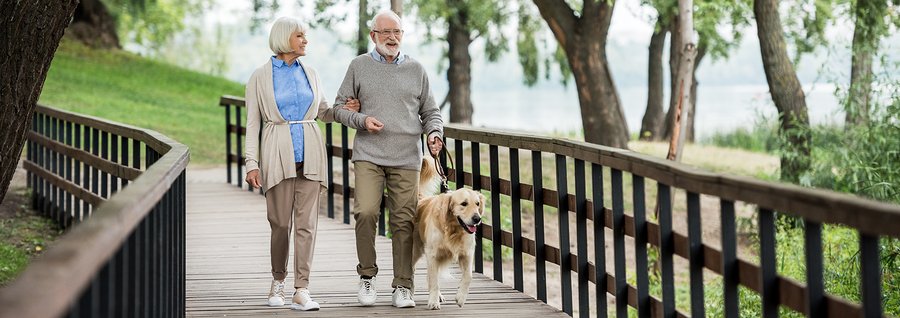If you are a dog owner, chances are good that you and your pup are very devoted to one another. The love and attention we enjoy from our devoted friends is a gift we receive every single day. And that can be even more important to us as we age and may not be quite as busy with work commitments and family responsibilities as we were in the past. But new research suggests there might also be a dangerous aspect to owning a dog in our senior years that just might lead to a trip to the hospital.
The study, which took place at the University of Pennsylvania in Philadelphia, found that walking a dog on a leash may increase the risk of bone fractures in older people.1Pirruccio, Kevin; et al. “Fractures in Elderly Americans Associated With Walking Leashed Dogs.” JAMA Surgery. 6 March 2019. Accessed 10 March 2019. http://jamanetwork.com/journals/jamasurgery/article-abstract/2727125 These results are based on an analysis of data collected by the National Electronic Injury Surveillance System of the United States Consumer Product Safety Commission. The investigators used this source to obtain information on visits to hospital emergency rooms across the country between 2004 and 2017.
Among individuals who were 65 or older, the researchers discovered there were more than 32,000 emergency department visits due to falls or compression fractures that occurred while walking a leashed dog during this 13-year period. What’s more, these occurrences seem to be on the rise. In 2004, there were approximately 1,670 dog walking-related fractures resulting in ER visits by older people, but by 2017 that number increased to roughly 4,400 cases. And women are experiencing these injuries much more frequently than men, with 78.6 percent of the fractures throughout the study period happening to women.
Why would older people be at risk of breaking a bone when they take Fido for a walk? There are likely several factors at play here. Bone density tends to begin decreasing before the age of 40, so by the time we reach our mid-60s and older, many people have far more fragile bones. And osteoporosis is much more prevalent in women—accounting for approximately 70 percent of cases—which may explain why more than three-quarters of the fractures due to dog walking in the research were in women.
Certain pharmaceutical drugs, such as cortisone, can also weaken bones over time if they are used long term. They may be recommended to treat some inflammatory conditions like asthma, arthritis, and psoriasis for long stretches or off and on over a long period and a potential side effect is loss of bone density. Other factors may include insufficient calcium (or some combination of magnesium, boron, and vitamin K) in the diet during the years when bone mass was increasing (from childhood through around the age of 20), as well as a current lack of vitamin D. This vitamin, which our bodies manufacture when we’re exposed to sunlight, is difficult to obtain from food sources alone and many people do not spend any time in the sun without using sunblock, thereby limiting their production of vitamin D.
Exercise is also an important contributor to bone health, and the growing number of sedentary adults in the United States may be one reason the incidence of fractures in older people was found to be on the rise. Weight-bearing workouts such as walking and tennis help us maintain strong muscles and bones as we age, and physical activities focused on flexibility, including stretching and yoga, can improve balance and make falls less likely.
Ultimately, if you own a dog, don’t start worrying that you might end up in the hospital due to your furry friend. There are huge benefits to dog ownership at all ages, such as companionship and the regular exercise that arises from walking your dog at least once a day. Just keep in mind a few things if you are older, like the importance of training your dog well if it is a larger breed to make sure it doesn’t lunge and knock you off balance.
If you don’t have a dog but are considering adopting one, you might want to choose a smaller breed if you think you won’t necessarily follow through on training. And in bad weather, when the chance of a slip or fall could be higher, let your dog out in a fenced area to do its business while you stay inside and do your workout.
References
| ↑1 | Pirruccio, Kevin; et al. “Fractures in Elderly Americans Associated With Walking Leashed Dogs.” JAMA Surgery. 6 March 2019. Accessed 10 March 2019. http://jamanetwork.com/journals/jamasurgery/article-abstract/2727125 |
|---|











